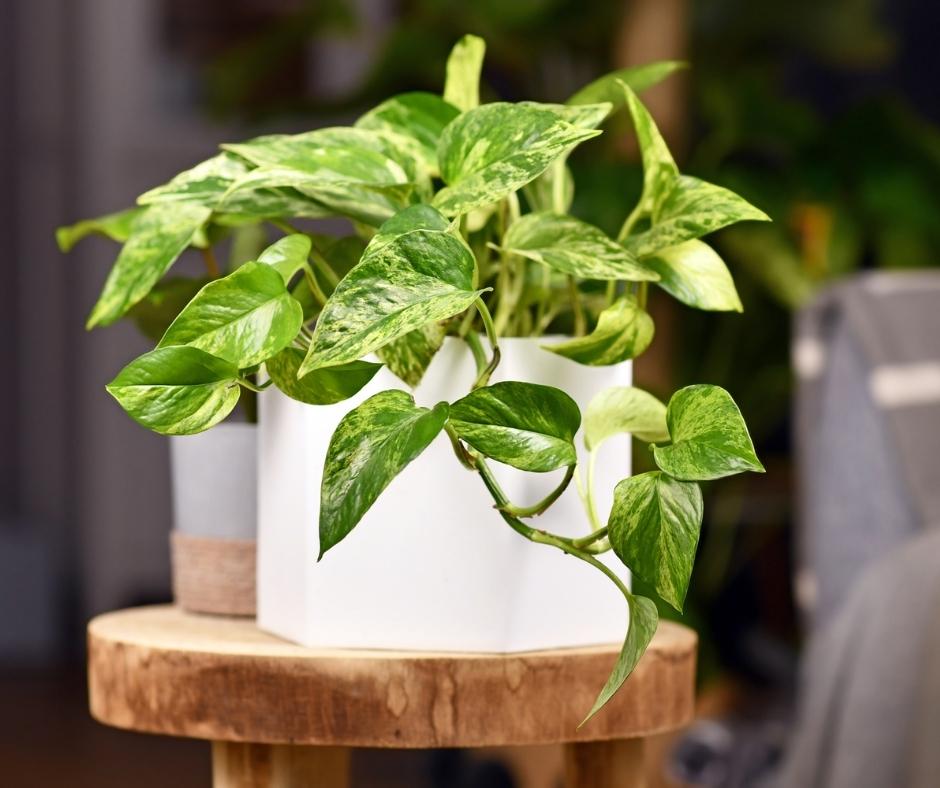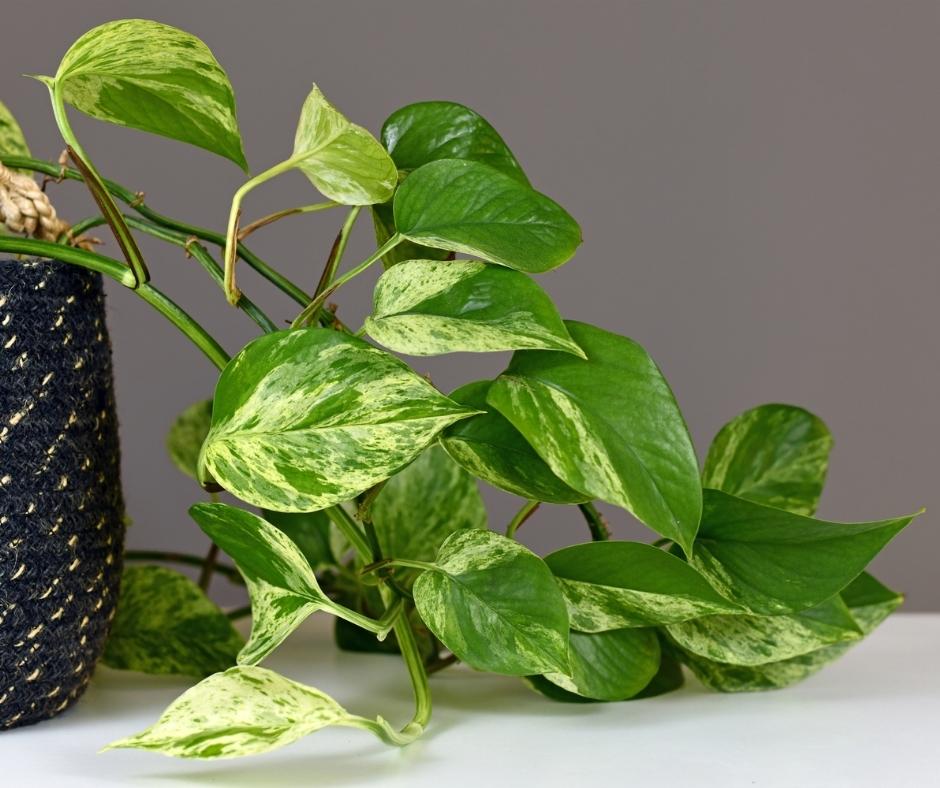
Marble Queen Pothos Care Guide
Pothos, or achira, is a very popular houseplant. Houseplants from the Pothos genus are highly coveted because they require little maintenance and look great with minimal care.
The marble queen pothos plants are ideal for novices and experts alike, as they provide something for everyone. In my experience, pothos plants are criminally underappreciated. Just because they’re popular doesn’t mean they aren’t beautiful.
The lime-colored stems and brilliant green variegated heart-shaped leaves of the marble queen pothos add instant color to any space. Its leaves are dotted with creamy white dots, which are only found on the marble queen. Some leaves may be quite heavily white, but they are generally green in color.
Marble Queen Basics
Epipremnum aureum, the scientific name of the marble queen, is a member of the Araceae family and comes from French Polynesia. Pothos plants originated in French Polynesia, which has a warm tropical climate. As a result, this queen is a tropical vine (like other pothos plants).
Pothos have now established themselves all throughout the world, and they are effectively an invasive species in many tropical locations due to their rapid development. This is where they get their name “devil’s ivy.” It may grow up to a foot or two long or 20+ feet long depending on its growth environment.
The queen pothos is similar to other pothos plants in that it may be used as ground cover, a climbing vine, or a little hanging plant. Because it isn’t cold-hardy and requires little care, the marble queen pothos is often kept as a houseplant by many individuals.
How much light does a marble queen pothos plant need?
Marble queens are robust, resilient, and can endure almost any lighting. However, if you want your plant to grow properly, mimicking its natural bright, indirect light is the way to go. Indoor conditions mean near your sunniest window; outdoors, it means in the shade beneath a tree or a covered patio.
Its lovely, speckled leaves may be damaged by direct sunlight. A bit of early morning sun is usually okay, but check your plant and see if the lighting is correct after you’ve moved it.
The low-light tolerance of this plant makes it ideal for offices and bedrooms. Just keep in mind that the less light they are exposed to, the fewer cream-colored spots they will have! Its leaves will compensate by becoming greener to allow them to take in as much light as possible (green = more chlorophyll, which plants require to
If you find your marble queen to be too green, move it to a more light-reflective location. We’ve got ours in our bedroom, which is far greener than some I’ve seen in brighter settings.

For soil, think well-draining
Your marble queen pothos’s soil mix doesn’t have to be expensive or sophisticated. Any well-draining soil will do. Look for something labeled “houseplants” or “indoor plants.”
The last thing you want to do is suffocate your marble queen with thick soil! It will retain too much water. If you think your soil is too heavy and want to lighten it up, consider adding an additional handful of coco coir, perlite, or both to aid drainage.
How much water does a marble queen pothos need?
I believe we’ve established that these plants can thrive almost everywhere. That said, the only difficult aspect about marble queen pothos care is watering. These tropical plants, believe it or not, prefer a drier soil.
When the top few inches of soil have dried out, you should water them. I sometimes let mine almost entirely dry out, and it’s important to only water when the top few inches of soil are dry. Allow any extra water to run through the drainage holes after watering the queen so that root rot doesn’t develop and leaves don’t droop.
However, if the leaves begin to brown, it’s an indication of underwatering. When it’s colder and the plant isn’t growing as rapidly, water your cactus only once every two weeks or so. Consider just misting the plant until spring arrives and monitoring how it progresses.
Temperature & Humidity
The ideal range for this vibrant beauty is between 65°F and 85°F, with temperatures of 60°F to 75°F being even better. It won’t do well outdoors in the winter! Low temperatures might cause the leaves to become discolored and develop dark spots.
Pothos plants, on the other hand, thrived in my covered patio space during the summer and with a few low-temperature dips into the 50s. Just don’t do it on a daily basis, and definitely don’t expose it to frost.
The marble queen pothos requires dry soil, but it still needs a lot of moisture. The higher the humidity level, the better, although (40-60%) will suffice in the average home. Place your pothos near other plants, in the bathroom, or on top of a water-filled pebble tray to boost humidity without
Personally, I don’t have much of a problem with humidifiers in my pothos plants indoors. The growth outside in the humid Maryland summers is considerably bigger and healthier, but I’m not going to worry about filling up a humidifier and cleaning it every day.
How to Propagate a Marble Queen Pothos Plant
Pothos is a popular houseplant, and the marble queen is no exception. The marble queen may be propagated in a number of ways, although it is one of the simplest plants to start with. First, verify that the mother plant is healthy. Then select a pretty vine with many nodes (nodes are where leaves attach to the stem
You may put your marble queen cutting in water for a few days before planting it in the soil. If you change the water every week or so, the cutting should develop roots after a few weeks. Then you can plant it and keep the soil wet for a week or two.
If you’re going to be planting it, don’t be concerned if it droops a little. It’s probably just recovering from some transplant trauma. You may also skip the water rooting and plant the cutting right into some new, well-drained soil. The nodes should be completely covered with dirt.
It’s critical to keep the soil wet for the first few days after propagation. Not to mention, keep it out of direct sunlight. In approximately two weeks, stem cuttings should be able to root, and you’ll be well on your way to a new marble queen pothos.
How to Propagate From Cuttings
Cutting a runner off of this plant is the simplest way to propagate it.
Pothos naturally root new vines on a regular basis. The simplest method to propagate a pothos plant is to remove the fourth or sixth leaf from a 4-6″ section of healthy stem and place it in a glass container with water. Make sure no leaves are submerged.
Place the jar and cutting in a warm, sunny location. They should be treated similarly to other houseplants. It’s best to transplant them into a potted container with soil once the cutting has roots (usually about a month after it starts growing roots). If it stays in the water too long, it might have problems adjusting to dirt.
Snow Queen Pothos vs. Marble Queen Pothos
Snow queen pothos and marble queen pothos are often mistaken for one another. And for good reason: they appear to be identical. The leaves are similar in shape and develop in the same manner. The main difference between the snow queen pothos and marble queen pothos is the color of their leaves, which is why they’re given the marble queen pothos name.
The marble queen pothos takes after marble cake. It’s marble-y green with white swirls, or it can be pure marble green without any white specks at all. The snow queen pothos has leaves that are mostly green with a slight speckling of silver/white, marble-y or otherwise.
The leaves of the marble queen pothos are green with cream-colored speckles and splotches, whereas the snow queen pothos leaves are mostly creamy white, with just a few green spots. Because it has more green, naturally the marble queen pothos grows much faster since it has greater amounts of chlorophyll.
The snow queen may take longer to develop, but it can still reach the size of the marble queen pothos. I also discovered that snow queen pothos grew poorly in typical home humidity-mine had a lot of browning on the white portions until I relocated it to a neighbor with more patience.
However, marble queen pothos does not tolerate low humidity well. As it dries out, the leaves will brown and wilt, resulting in leaf drop.
Manjula Pothos vs. Marble Queen Pothos
The marble queen pothos and manjula pothos are frequently mixed up. The form of the leaves of the marble queen pothos differs significantly from that of manjula pothos plants. The heart-shaped leaves of the marble pothos grow flattened, broad, and bright green with creamy speckles.
The manjula pothos, on the other hand, has leaves that are more three-dimensional. I mean they curl and bend, giving the vine plant a more wavy appearance. The leaves of the manjula, however, are green as well.
Frequently Asked Questions About Marble Queen Pothos
Are marble queen pothos plants toxic to pets?
Unfortunately, yes. Pothos plants in general are not safe for pets to eat. As a result, I keep my pothos plants hanging or out of reach from my inquisitive cats. They include calcium oxalates, which can lead to oral discomfort and burning, vomiting, and other symptoms.
Do marble queen pothos need direct sunlight?
Give marble queen pothos bright, filtered light. Bright light encourages the marble queen pothos to grow its best! It is best placed in indirect sunlight or in bright artificial lighting, such as fluorescent or LED lights. Avoid placing marble queen pothos in direct sun because it will cause the leaves to burn and turn brown.
How do marble queen pothos reproduce themselves? How does it propagate itself?
The marble queen plant reproduces by growing baby vines off of an existing vine or stem, much like a spider plant does. You can also choose to propagate marble king pothos through root division, leaf-cutting propagation, air layering, tissue culture, and seed.
Is marble queen pothos a succulent?
No! Marble queen pothos is not a cactus or a succulent-it is an herbaceous vine plant. They take on characteristics of both succulents and cacti, but marble queens are not either one of them.
Do marble queen pothos grow well in water?
Marble queens are not aquatic plants! As I said before, marble queen pothos struggles with average household humidity. If you’d like to learn how to care for marble queen pothos inside your home or outside in the garden, continue reading below!
Where can I buy a Snow Queen Pothos plant?
You can find marble queen pothos plants for sale at your local garden center. You can also purchase marble queen pothos online at Amazon.
Final Thoughts On Snow Queen Pothos Care
The marble queen pothos plant is one of the most popular hanging house plants, and for good reason. They are easy to care for, grow quickly, and they look wonderful dangling from planters! Next time you’re at the garden center looking for something lush and green to brighten up your home or office, consider marble king pothos as a choice!
If you found this article helpful, please take a moment to share it on social media using the buttons below.
